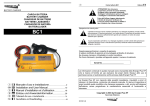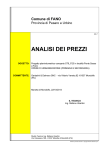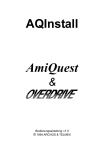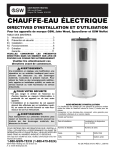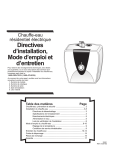Download Lindy USB 2.0 Data Dock
Transcript
Included Items USB Data Dock 2.5” HDD Data Tray LINDY No’s: 42976, 42977, 42978, 42979, 42986, 42987, 42988, 42989 www.lindy.com 2.5” HDD Data Tray Installation 1 USB Data Dock 2.5” HDD Data Tray 1 x USB Data Dock 1 x 2.5” HDD Tray 1 x USB Hub Tray 1 x Card Reader Tray 1 x Internal USB cable 4 x Installation screws 1 x Dual Power USB Cable 1 x Carry Wallet This manual 1 x 2.5” HDD Tray 1 x Dual Power USB Cable 1 x Carry Wallet This manual UK Remove the top cover from the drive tray. You may find it easier to lever the cover upwards from the USB port opening. DE Öffnen Sie die beiden Gehäusehälften des Festplattenghäuses. Sie werden lediglich durch einen federnden Klemmmechanismus gehalten FR Retirez le dessus du boîtier. Vous pouvez l’ouvrir facilement en faisant levier depuis le port USB. IT Rimuovere la metà superiore dell’astuccio. L’operazione risulta più semplice facendo leva sulla feritoia della porta USB. 3 2 UK To complete the installation, carefully replace the top cover. Ensure the LEDs and the case tabs are correctly located. DE Fügen Sie sorgfältig die beiden Gehäusehälften wieder aufeinander. Achten Sie auf das korrekte Einrasten der Gehäusehälften und die Positonierung der LEDs! FR Pour terminer l’installation, replacez le dessus du boîtier avec précaution. Assurez vous que les LEDs soient visibles. IT Per completare l’installazione, risistemare la copertura. Assicurarsi che i LED siano allocati correttamente. 2.5” HDD PCB 4 UK Remove the PCB and protective card. Carefully plug your 2.5” HDD into the PCB and then place them both into the drive tray. DE Setzen Sie die Platine mit dem Anschlusstecker auf die Festplatte.! Die Schutzfolie gehört unter die Platinenseite der Festplatte ! FR Retirez le PCB et la carte protectrice. Branchez soigneusement votre disque 2.5” dans le PCB et placez le tout dans le boîtier IT Per completare l’installazione, risistemare la copertura. Assicurarsi che i LED siano allocati correttamente. UK Connect the data tray(s) to an external USB port using the supplied Dual Power USB Cable. For the 2.5” HDD Tray, you can connect the red USB connector to a second USB port for additional power. DE Schließen Sie das Gehäuse mit dem Dual Power USB-Kabel an einen USB Port / Hub mit Stromversorgung an. Sie benötigen den roten USB Stecker nur falls ihre Festplatte viel Strom benötigt (zuerst anschließen). FR Connectez le boîtier data tray à un port externe USB avec le câble Dual Power USB fourni. Pour le tiroir 2.5” HDD, vous pouvez connecter le connecteur USB rouge à un second port USB pour plus de puissance. IT Collegare gil/l’astucci/o in una porta USB esterna tramite il cavo USB Dual Power incluso nella fonritura. Per alimentare HD da 2.5”, collegare anche il connettore USB rosso in una seconda porta USB. Data Dock Installation 1 2 UK Switch off and unplug your computer! Remove your computer’s case cover and slide the Data Dock into an available 3.5” bay. Secure the Data Dock using the 4 supplied screws UK Use the supplied internal USB cable and a 3.5” type power plug from the PC’s PSU to make the connections as illustrated. Installation is now complete; reassemble and switch on your PC. DE Trennen Sie Ihren Rechner von der Netztspannung und installieren Sie das Data Dock in einem freien 3,5“ Schacht mit den beiliegenden Schrauben. DE 1) Das beiliegende interne USB Kabel verbindet das Data Dock mit Mainboard bzw. USB Karte. 2) Rechts hinten wird ein 3,5” Stromanschluss vom PC Netzteil angeschlossen. FR Eteignez et débranchez votre ordinateur! Retirez le cache et glissez le Data Dock dans une baie 3.5” libre. Fixez le boîtier rack data dock avec les 4 vis fournies FR Utilisez le câble USB interne et une prise d’alimentation du PC tel qu’illustré ci-dessous. L’installation est maintenant terminée; réalimentez et démarrez votre ordinateur! Spegnere e scollegare il computer! Rimuovere la cover di uno slot da 3,5” libero ed inserire il Data Dock. Assicurare il Data Dock al case utilizzando le 4 viti incluse nella fornitura. IT Utilizzare il cavo USB interno e collegarlo alla PSU del PC come illustrato nello schema sottostante. L’installazione è completata; riassemblare ed accendere il computer! IT To Motherboard USB Pin Header ! Refer to your motherboard manual for the location of the USB Pin Header ! Die Position des USB Anschluss finden Sie in Ihrem Mainboard Handbuch ! ! Référez vous au manuel de votre carte mère pour repérer le connecteur USB !Consultare il manuale della motherboard per effettuare il collegamento 3 UK You can plug the data trays into Tray Input 1 or 2. The LED will glow blue to indicate correct insertion. To eject the data tray, click the ‘Safe Removal’ icon on your Windows task bar and then press the eject button. DE Sie können die Einschübe beliebig in beiden Schächten des Data Dock verwenden. Eine blaue LED zeigt Betriebsbereitschaft an. Verwenden Sie „Hardware sicher entfernen“ bevor Sie einen Einschub auswerfen. FR Vous pouvez connecter les data trays (tiroirs) dans l’entrée 1 ou 2. La LED s’allumera bleue pour indiquer une bonne insertion. Pour éjecter le data tray, cliquez sur ‘Retirez mon périphérique’ dans la barre des tâches. IT E’ possibile collegare gli astucci nell’ingresso 1 o 2. Si accenderà il LED blu per indicare il collegamento corretto. Per estrarre l’astuccio, cliccare l’icona ‘Safe Removal’ sul task di Windows e premere il tasto eject. Click the Task Bar ‘Safe Removal’ icon before ejecting a data tray CE Statement This device complies with the European Regulations for Electromagnetic Compatibility (EMC) of the European Union and it is equipped with the CE mark. This unit has to be used with high quality shielded connection cables. Only if these high quality shielded cables are used it can be sure that the EMC compatibility is not adversely influenced. FCC Statement Shielded cables must be used with this equipment to maintain compliance with radio frequency energy emission regulations and ensure a suitably high level of immunity to electromagnetic disturbances. FCC Warning This equipment has been tested and found to comply with the limits for a Class B Digital device, pursuant to part 15 of the FCC Rules. These limits are designed to provide reasonable protection against harmful interference in a residential installation. This equipment generates, uses, and can radiate radio frequency energy and, if not installed and used in accordance with the instructions, may cause harmful interference to radio communications. However, there is no guarantee that interference will not occur in a particular installation. If this equipment does cause harmful interference to radio or television reception, which can be determined by turning the equipment off and on, the user is encouraged to try to correct the interference by one or more of the following measures: Reorient or relocate the receiving antenna Increase the separation between the equipment and receiver Connect the equipment into an outlet on a circuit different from that to which the receiver is connected Consult the dealer or an experienced technician for help You are cautioned that changes or modifications not expressly approved by the party responsible for compliance could void your authority to operate the equipment. WEEE (Waste of Electrical and Electronic Equipment), Recycling of Electronic Products In 2006 the European Union introduced regulations (WEEE) for the collection and recycling of all waste electrical and electronic equipment. It is no longer allowable to simply throw away electrical and electronic equipment. Instead, these products must enter the recycling process. Each individual EU member state has implemented the WEEE regulations into national law in slightly different ways. Please follow your national law when you want to dispose of any electrical or electronic products. More details can be obtained from your national WEEE recycling agency. Germany / Deutschland Die Europäische Union hat mit der WEEE Direktive umfassende Regelungen für die Verschrottung und das Recycling von Elektro- und Elektronikprodukten geschaffen. Diese wurden von der Bundesregierung im Elektround Elektronikgerätegesetz – ElektroG in deutsches Recht umgesetzt. Dieses Gesetz verbietet vom 24.März 2006 an das Entsorgen von Elektro- und Elektronikgeräten über die Hausmülltonne! Diese Geräte müssen den lokalen Sammelsystemen bzw. örtlichen Sammelstellen zugeführt werden! Dort werden sie kostenlos entgegen genommen. Die Kosten für den weiteren Recyclingprozess übernimmt die Gesamtheit der Gerätehersteller. st 1 Edition May 2007 www.lindy.com
This document in other languages
- français: Lindy USB 2.0 Data Dock
- Deutsch: Lindy USB 2.0 Data Dock
- italiano: Lindy USB 2.0 Data Dock


